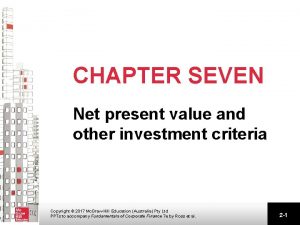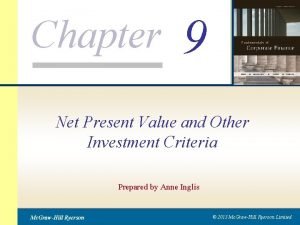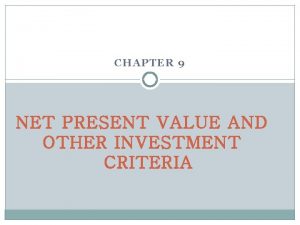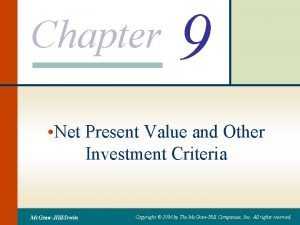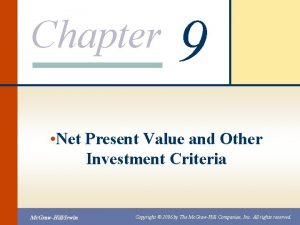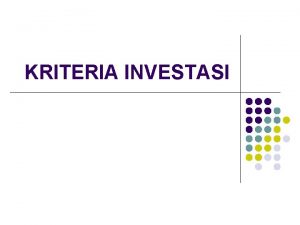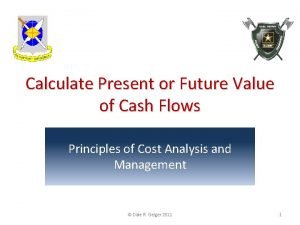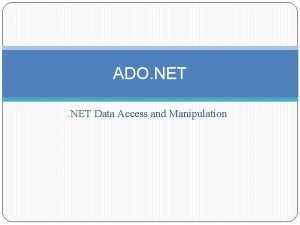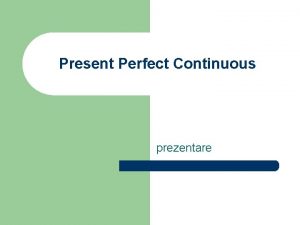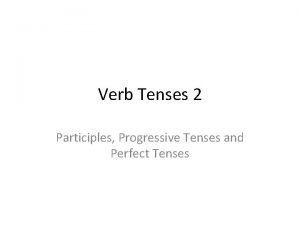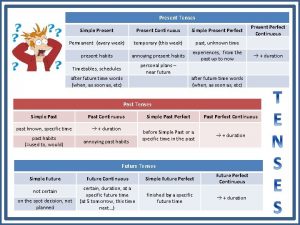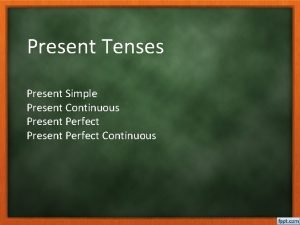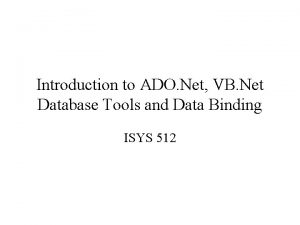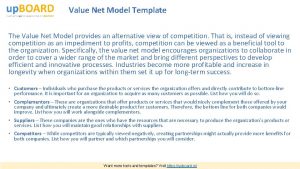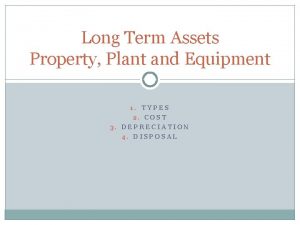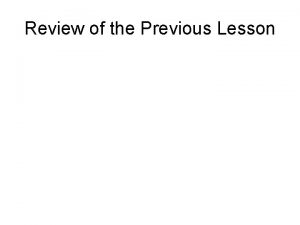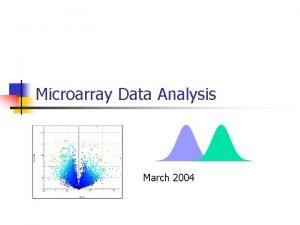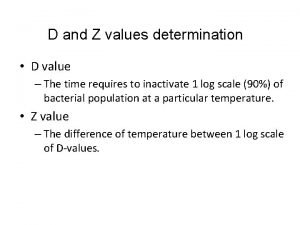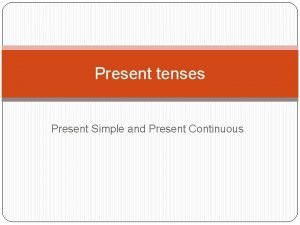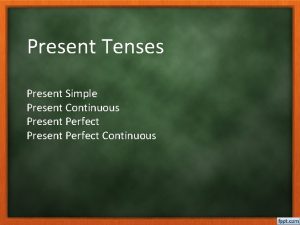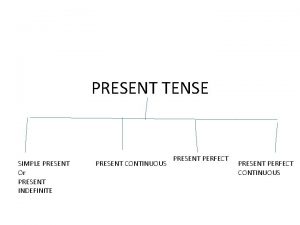Net Present Value RWJChapter 9 Overview n In
































- Slides: 32

+ Net Present Value RWJ-Chapter 9

+ Overview n In late 2014, Tesla Motors Inc. (which manufactures electric cars), announced its plans to open a factory in the USA at a cost of $5 billion. n Tesla’s new plant is an example of capital budgeting decision. Decisions such as these, with a price tag of $5 billion, are major undertakings, and risks and rewards must be carefully weighed. n In this chapter, we discuss the basic tools used in making such decisions.

+ Mutually Exclusive vs. Independent Projects n Mutually Exclusive Projects: only ONE of several potential projects can be chosen, e. g. acquiring an accounting system. n RANK all alternatives and select the best one. n Independent Projects: accepting or rejecting one project does not affect the decision of the other projects. n Must exceed a MINIMUM acceptance criteria.

+ The Net Present Value (NPV) n Net Present Value (NPV) = Total PV of future CF’s + Initial Investment n Estimating NPV: 1. Estimate future cash flows: how much? and when? 2. Estimate discount rate 3. Estimate initial costs n Minimum Acceptance Criteria: Accept if NPV > 0 n Ranking Criteria: Choose the highest NPV

+ NPV Example n Alpha Corp. is considering investing in a riskless project costing $100. The project receives $107 in one year and has no other cash flows. The risk-free interest rate is 6%. n NPV of the project is: $0. 94= -100 + (107/1. 06) n NPV is positive, accept the project. n NPV leads to good decisions. Why?

+ NPV Example (Contd. ) n Consider these two strategies: 1. 2. Use $100 of corporate cash to invest in the project. The $107 will be paid as a dividend in one year. Forgo the project and pay the $100 of corporate cash as a dividend today. n If strategy 2 is employed, the shareholders might deposit the dividend in the bank for one year. With the interest rate of 6 percent, strategy 2 will produce cash of $100 x 1. 06 =$106 at the end of year 1. n Which strategy would the shareholders prefer?

+ How do We Interpret NPV? n In the previous example, NPV of the project was $0. 94. n Let’s say the firm today has productive assets worth $V and has $100 of cash. If the firm foregoes the project, the value of the firm today would be: $V +100 n If the firm accepts the project, the firm will receive $107 in one year but will have no cash today. V + 107/1. 06 n The difference between the two equations is $0. 94, i. e. NPV The value of the firm rises by the NPV of the project.

+ Discount Rate in NPV Calculations n In the previous example, we assumed that the project was riskless. In real life, the future cash flows from a project are estimated rather than known. n Let’s say, Alpha Corp. estimates that with 50% chance the cash flow will be $117, or it will be $97. The expected cash flow will be (0. 5) (117) +(0. 5) (97)= $107 n Suppose the project is as risky as the market and expected return on the market is 10%. n NPV= -100 + 107/1. 10 = -$2. 73 n Expected return on the project is 7%. If the investors gets the cash in dividends and invest it at the market, the expected return is 10%.

+ Why Use Net Present Value? n Accepting positive NPV projects benefits shareholders. ü NPV uses all the cash flows of the project ü NPV discounts the cash flows properly

+ 9. 2 The Payback Period n How long does it take the project to “pay back” its initial investment? n Payback Period = number of years to recover initial costs n Minimum Acceptance Criteria: n n set by management Ranking Criteria: n set by management

+ Example-Payback Period n Here are the projected cash flows from a proposed investment: Year Cash Flows 1 10 2 60 3 80 n This project costs $100. n What is the payback periods?

+ Example – Calculating Payback Period

+ The Payback Period Rule (continued) n Disadvantages: n n n n Ignores the time value of money Fails to consider risk Ignores cash flows after the payback period Biased against long-term projects Requires an arbitrary acceptance criteria A project accepted based on the payback criteria may not have a positive NPV Advantages: n n Easy to understand Biased toward liquidity

+ The Payback Period - Uses n In relatively small decisions since it is simple. n Firms with good investment opportunities but no available cash. Quick cash recovery enhances the reinvestment possibilities for such firms. n Firms prefer NPV when they look at bigger projects.

+ The Profitability Index (PI) n Minimum Acceptance Criteria: n n Accept if PI > 1 Ranking Criteria: n Select alternative with highest PI

+ The Profitability Index n Disadvantages: n n Problems with mutually exclusive investments Advantages: n May be useful when available investment funds are limited n Easy to understand communicate n Correct decision when evaluating independent projects

+ The Average Accounting Return n Another attractive but fatally flawed approach. n Ranking Criteria and Minimum Acceptance Criteria set by management n Disadvantages: n n Ignores the time value of money Uses an arbitrary benchmark cutoff rate Based on book values, not cash flows and market values Advantages: n n The accounting information is usually available Easy to calculate

+ Example-AAR n You are deciding whether to open a store in a new shopping mall. The required investment is $500, 000. n The required investment would be 100% depreciated (straight-line) over the five years. n The following table provides yearly revenue and costs for average accounting return: Year 1 Year 2 Year 3 Year 4 Year 5 Revenue 433, 333 450, 000 266, 667 200, 000 133, 333 Expenses 200, 000 150, 000 100, 000 EBITDA 233, 333 300, 000 166, 667 100, 000 33, 333 Depreciation 100, 000 100, 000 EBIT 133, 333 200, 000 66, 667 0 -66, 667 Taxes 33, 333 50, 000 16, 667 0 -16, 667 NI 100, 000 150, 000 0 -50, 000

+ Example-AAR or

+ The Internal Rate of Return (IRR) n IRR: the discount rate that sets n Minimum Acceptance Criteria: n Accept if the IRR exceeds the required return. n Ranking n Criteria: Select alternative with the highest IRR n Reinvestment n NPV to zero assumption: All future cash flows assumed reinvested at the IRR. n Disadvantages: n n n Does not distinguish between investing and borrowing. IRR may not exist or there may be multiple IRRs. Problems with mutually exclusive investments. n Advantages: n Easy to understand communicate

+ The Internal Rate of Return: Example n Consider the following project: $50 0 1 $100 2 -$200 n The internal rate of return for this project is 19. 44% $150 3

+ The NPV Payoff Profile for This Example n If we graph NPV versus discount rate, we can see the IRR as the x-axis intercept.

+ Problems with the IRR Approach • • General problems affecting both independent and mutually exclusive projects: • Investing or Financing • Multiple IRRs Problems specific to mutually exclusive projects: • The Scale Problem • The Timing Problem

+ Investing or Financing? n Two different projects n n Project A (Investing type) n CF 0 = -100 n CF 1 = 130 n NPV @10% = $18. 2 n IRR = 30% Project B (Financing type) n CF 0 = 100 n CF 1 = -130 n NPV @10% = -$18. 2 n IRR = 30% IRR is greater than discount rate in both cases. But Project B’s NPV is negative. IRR rule is reversed for financing type projects.

+ Multiple IRRs n There are two IRRs for this project: Which one should we use? 100% = IRR 2 0% = IRR 1

+ How Do We Solve Multiple IRR Problem? n Rely on NPV when cash flows are non-normal. n OR calculate Modified Internal Rate of Return (MIRR) n Three steps to calculate MIRR (Combination approach): n n n Find the PV of cash outflows Find the FV of cash inflows Find the rate of return which makes the FV of cash inflows equal to PV of cash outflows (MIRR)

+ The Scale Problem (of IRR) • Suppose that a friend promises to pay you $2 tomorrow if you lend him $1 today. This deal promises a return of 100% (IRR). • Another friend asks you to lend him $100 today in exchange of $150 tomorrow. IRR on this deal is 50%. • Which one would you choose? • The first deal increases your wealth by $1 (NPV), the second deal increases your wealth by $50.

+ The Timing Problem n The preferred project in this case depends on the discount rate. NPV of project B is higher with low discount rates and the NPV of project A is higher with high discount rates.

+ The Timing Problem

+ Calculating the Crossover Rate n Compute the IRR for either project “A-B” or “B-A”

+ IRR vs. NPV n Either due to differences in timing or in size, the project with the highest IRR need not have the highest NPV. n When working with mutually exclusive projects, it is very common that you will face scale or timing problem. Then you should simply use NPV.

+ IRR vs. NPV Consider these two statements: n n 1. You must know the discount rate to compute NPV of a project but you can compute the IRR without referring to the discount rate. 2. Hence, the IRR rule is easier to apply than the NPV rule because you don’t use the discount rate when applying IRR. First statement is true, while the second statement is not.
 Value creation value delivery value capture
Value creation value delivery value capture Net present value discounted cash flow
Net present value discounted cash flow Npv
Npv Net present value of investment
Net present value of investment Net present value and other investment criteria
Net present value and other investment criteria Net present value
Net present value Advantages and disadvantages of payback method
Advantages and disadvantages of payback method Npv meaning
Npv meaning Npv profiles
Npv profiles Chapter 9 net present value and other investment criteria
Chapter 9 net present value and other investment criteria +pva
+pva Npv meaning
Npv meaning Npv adalah
Npv adalah Present value table
Present value table Ado.net overview
Ado.net overview Present perfect present simple present continuous
Present perfect present simple present continuous Present simple present continuous present perfect
Present simple present continuous present perfect Present simple schema
Present simple schema Which verb tenses describe continuing action?
Which verb tenses describe continuing action? Do and does usage
Do and does usage Present simple present continuous present perfect
Present simple present continuous present perfect Present simple present continuous and present perfect
Present simple present continuous and present perfect Achmed lach net ich krieg mein tach net
Achmed lach net ich krieg mein tach net Ado.net vb.net
Ado.net vb.net The value net model
The value net model Net realizable value formula
Net realizable value formula Net book value
Net book value Lcnrv adalah
Lcnrv adalah Ias 2 net realisable value
Ias 2 net realisable value Value received and value parted with
Value received and value parted with Calculate p value formula
Calculate p value formula D value and z value
D value and z value Acid value and saponification value
Acid value and saponification value



